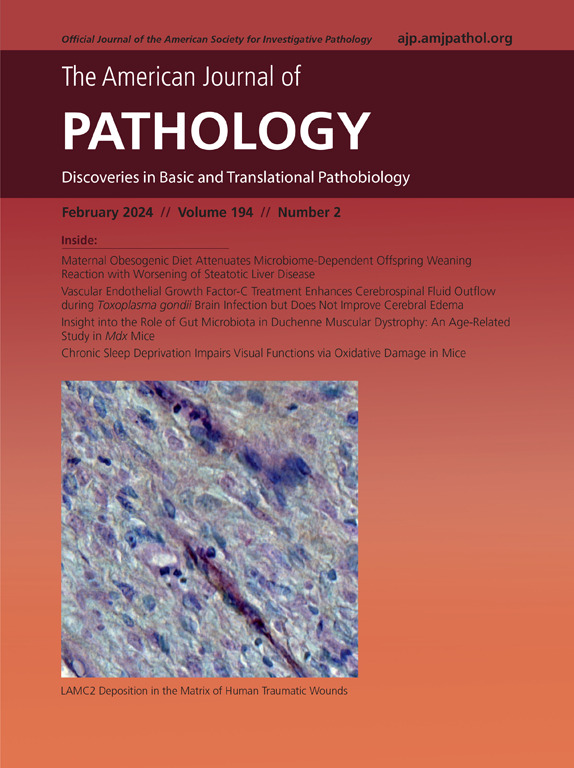Peroxisome Proliferator-Activated Receptor α/γ and Cannabinoid Receptor 2 Agonist Attenuated Nonalcoholic Steatohepatitis Exosome-Related Abnormalities in Mice
IF 4.7
2区 医学
Q1 PATHOLOGY
引用次数: 0
Abstract
This study explored the mechanisms and effects of 1 month of peroxisome proliferator-activated receptor (PPAR)α/γ agonist aleglitazar (10 mg/kg per day) or cannabinoid receptor 2 (CB2R) agonist JWH015 (3 mg/kg per day), alone or combined, on visceral adipose tissue (VAT)–derived extracellular vesicle (EV) release and associated systemic/VAT inflammation, decreased VAT capillary density/fibrosis, and intestinal inflammation/hyperpermeability in nonalcoholic steatohepatitis (NASH) mice. High EV release from VAT of NASH mice was associated with severe systemic/VAT/intestinal inflammation, reduced capillary network of VAT, and intestinal hyperpermeability. Combined JWH015 with aleglitazar treatment suppressed high-fat diet–induced obesity/adiposity, inhibited VAT expansion, reduced VAT inflammation/fibrosis, normalized VAT capillary network, and attenuated intestinal mucosal injury, inflammation, and hyperpermeability in NASH + aleglitazar + JWH015 mice. The inhibition of adipose tissue (AT)–derived EV release and hypoxia-inducible factor (HIF)1α levels in AT-derived EV, normalization of CB2R, PPARα, PPARγ, PPARγ1, PPARγ2, tight junction proteins, vascular endothelial growth factor/CD31 expression, and down-regulation of HIF1α, monocyte chemoattractant protein-1, and transforming growth factor-β1 were observed in the VAT and intestine of the NASH + aleglitazar + jwh015 group. In vitro experiments revealed that PPARα/γ and CB2R activation attenuated NASH AT-derived EV–induced pathogenic changes in the J774/SVEC4-10/Caco2/3T3-L1 cell system. This study suggested that VAT-derived EVs contribute to the pathogenesis of NASH and that combined PPARα/γ and CB2R agonist treatment ameliorated the abovementioned abnormalities of NASH mice.
慢性 PPARα/γ 和 CB2R 激动剂治疗可减轻 NASH 小鼠内脏脂肪组织(VAT)衍生的细胞外囊泡相关的 VAT 和肠道异常。
本研究探讨了慢性过氧化物酶体增殖激活受体(PPAR)α/γ和大麻素受体2(CB2R)激动剂对内脏脂肪组织(VAT)衍生的细胞外囊泡(EVs)释放和相关的全身/VAT炎症、VAT毛细血管密度降低/纤维化以及非酒精性脂肪性肝炎(NASH)小鼠肠道炎症/高渗透性的机制和综合影响。NASH 小鼠单独或同时接受 PPARα/γ 激动剂 aleglitazar(10 毫克/千克/天)、CB2R 激动剂 JWH015(3 毫克/千克/天)治疗 1 个月。NASH 小鼠血管内皮生长因子的高EV释放与严重的全身/血管内皮生长因子/肠道炎症、血管内皮生长因子毛细血管网减少和肠道高渗透性有关。JWH015与阿来替扎联合治疗可显著抑制HFD诱导的肥胖/脂肪肝,抑制VAT扩张,减轻VAT炎症/纤维化,使VAT毛细血管网正常化,并减轻NASH+aleg+JWH015小鼠的肠粘膜损伤、炎症和高渗透性。在NASH+aleg+JWH015组小鼠的VAT和肠道中,观察到AT源性EV释放和低氧诱导因子(HIF)1α水平受到抑制,CB2R、PPARα、PPARγ、PPARγ1、PPARγ2、紧密连接蛋白、VEGF/CD31表达正常化,HIF1α、MCP-1和TGFβ1下调。体外实验显示,在J774/SVEC4-10/Caco2 /3T3-L1细胞系统中,PPARα/γ和CB2R激活可减轻NASH AT衍生EV(EVnash)诱导的致病性变化。这项研究表明,VAT衍生的EV有助于非酒精性脂肪肝的发病机制,PPARα/γ和CB2R激动剂联合治疗可减少VAT释放的EV释放和HIF1/MCP-1信号,从而改善NASH小鼠的肝脏脂肪变性和VAT/肠道异常。
本文章由计算机程序翻译,如有差异,请以英文原文为准。
求助全文
约1分钟内获得全文
求助全文
来源期刊
CiteScore
11.40
自引率
0.00%
发文量
178
审稿时长
30 days
期刊介绍:
The American Journal of Pathology, official journal of the American Society for Investigative Pathology, published by Elsevier, Inc., seeks high-quality original research reports, reviews, and commentaries related to the molecular and cellular basis of disease. The editors will consider basic, translational, and clinical investigations that directly address mechanisms of pathogenesis or provide a foundation for future mechanistic inquiries. Examples of such foundational investigations include data mining, identification of biomarkers, molecular pathology, and discovery research. Foundational studies that incorporate deep learning and artificial intelligence are also welcome. High priority is given to studies of human disease and relevant experimental models using molecular, cellular, and organismal approaches.

 求助内容:
求助内容: 应助结果提醒方式:
应助结果提醒方式:


